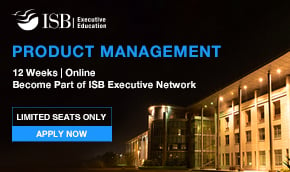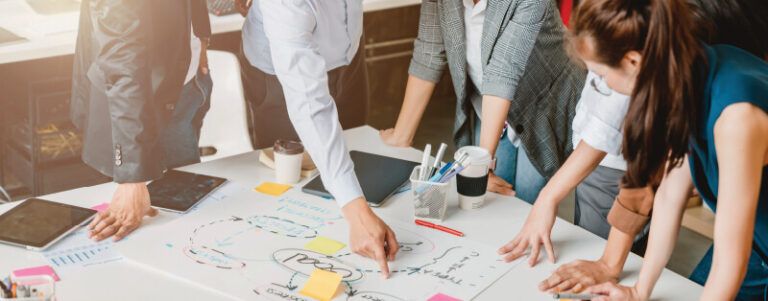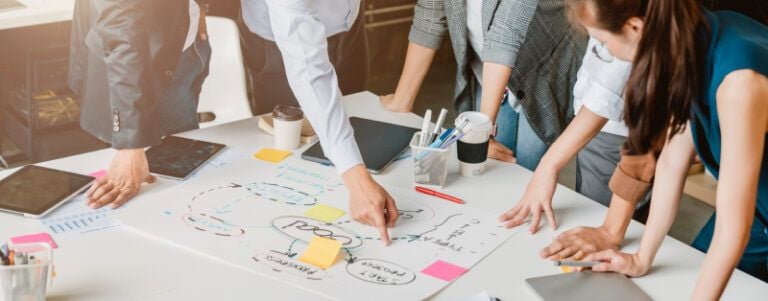Heart and Circles: Impact of Concepts in the Product Design Process

Product design refers to the process of identifying market opportunities, clarifying issues, developing solutions for the problems, and validating the solutions. The process is executed using the design thinking approach.
During the process, the product development team might come across various questions related to product design and product improvement. Did you know that there are particular frameworks to find answers to these questions without worrying too much?
This article will explore in detail two frameworks useful for answering questions associated with product design and improvement.
The HEART Framework
If you are not a hopeless romantic, this might seem a little scary to you. But the framework is in no way related to the organ pumping oxygen and swiftly catching feelings for the cute stranger you spotted on the bus.
The HEART framework is a method for improving the user experience of the software. It enables businesses to assess different aspects of user experience as per five metrics. These metrics stand for the acronym HEART:
- Happiness: A measure of user satisfaction. It is usually evaluated by user surveys and NPS responses.
- Engagement: It refers to the level of use an average is receiving from a product. Engagement is measured using in-product analytics, like the number of shares, time spent in-app, and number of sessions.
- Adoption: It refers to the percentage of users adopting the product or its specific features. It can be measured using in-product analytics like new subscriptions, new purchases, and upgrades.
- Retention: The total number of users returning to the product. It is usually calculated from the churn rate.
- Task Success: It focuses on a user’s ability to complete tasks. Task success is usually measured by looking at in-app task completion and error rates.
Google and the HEART Framework
Google developed the framework in 2010 to efficiently measure user experience efforts. At that time, product teams had access to user experience metrics on a micro level, like task completion rate. However, they lacked macro business metrics.
The framework helped bridge the gap and is presently used by multiple UX teams. It helps them identify concrete goals and determine success. Let us focus on how the company uses the framework to improve one aspect of the user experience.
The Way Google Enhances User Retention
User retention is a crucial factor for any business to improve its revenue. Therefore, it’s not surprising that Google invests a lot in its retention efforts. With Google’s acquisition of Nest in 2014, the company also acquired the users of Nest.
Google retains its customers of Nest by sending Nest Thermostat users a monthly summary of their energy consumption. On the surface, the email is simply about updating users about their annual thermostat usage. But at a deeper level, the email helps users remember the value of the product.
Users find it rewarding to notice the usage numbers going down every month. The report also offers a comparison of the energy efficiency of users in the area.
The element of competition urges users to earn more leaves month after month. The leaves serve as an indication of energy-efficient temperatures.
The CIRCLES Framework
The CIRCLES framework is a problem-solving method for the product management process. It enables product managers to develop thoughtful and complete answers to design questions. The design questions can develop for different types of products and services, from an automobile to a mobile application.
A few common product design questions that can be answered using this framework are as follows:
- What is the product?
- Who are the intended users?
- Why do the users need the product?
- How does the product function?
Steps Involved in the CIRCLES Method
Understanding the seven steps in the CIRCLES method will also help you dig the meaning of the acronym:
Comprehend the Situation:
An in-depth understanding of contextual information related to the creation of the product is necessary. It includes knowledge about the product life cycle, the development process, the purpose of the design, and the intended users. The stage is all about understanding the value of the product.
Identify the Customer:
There’s no use in developing, researching, and designing a new product without any end-user in mind. The product management team always needs to understand the needs, preferences, and interests of customers before developing a product.
Report the Needs of Customers:
The step is a continuation of the previous one and concerns the target audience. After identifying the needs, the design team must communicate what the users want and how the product can satisfy their requirements.
Cut, Through Prioritisation:
A business has various goals like customer satisfaction and revenue maximisation. However, achieving them requires various external considerations like time, labour, and capital. The step involves prioritising goals depending on external considerations.
List Solutions:
The step involves listing potential issues that might be faced by customers along with their solutions. Any product designed without a solution is a huge challenge for the company’s success.
Evaluate Trade-offs:
A product manager must remember various factors during the product design process, like customer satisfaction and ease of implementation. The product team needs to balance these considerations and analyse trade-offs necessary for achieving objectives without forgetting about the limitations.
Summarise Your Recommendation:
The last step is a summary of the different aspects involved in the design process. It sheds light on all the design aspects covered in the first six steps of the CIRCLES framework.
Parting Words
Whenever you come across a product design question, implement the CIRCLES framework to answer it. The HEART framework comes into play while answering product improvement questions. The two methods are extremely useful during the overall product development process.
All product managers should have knowledge about these methods to ace their jobs. And we can’t deny the importance of professional training in this regard. For the best training and knowledge acquisition in design thinking, Emeritus India will offer professional courses and certificate programs. Get in touch with us today to boost your career as a product designer!
FAQs:
Can the HEART framework increase ROI?
The HEART framework might not help ROI. But it can be used to better predict the ROI. It will help user experience teams to understand where to place their investments.
Who can benefit from the HEART framework?
The HEART framework is beneficial for the user experience team of any software. The five elements in the framework are essential for improving user experience.
How does the CIRCLES method support prioritisation?
The CIRCLES method helps determine the intended users and purpose behind building a product. It helps product management teams prioritise things like user feedback, product features, and product roadmap.
Who created the CIRCLES method and why?
The CIRCLES method was invented by Lewis C. Lin. The method helps clarify goals like engagement and revenue maximisation. It also helps with understanding constraints and acquiring foundational knowledge of a product and its target users.











